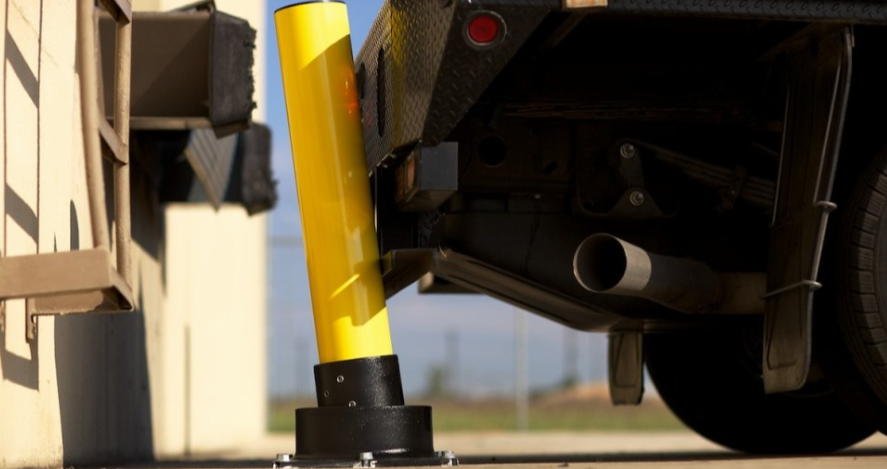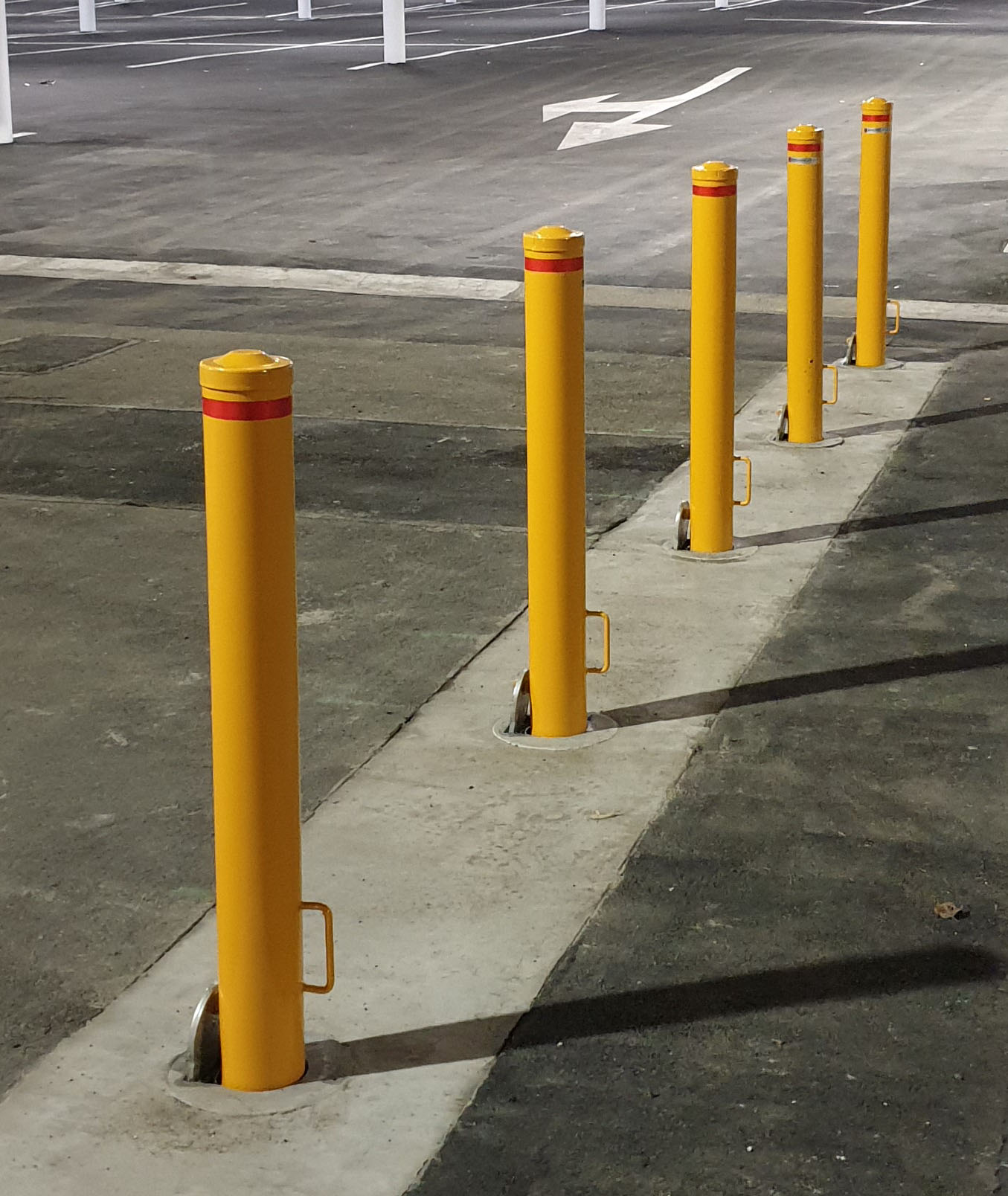When protecting your valuable assets, compromising security is not an option. To ensure your building and site are protected from vehicles, forklifts and heavy equipment, security bollards are a proven way to restrict and guide vehicles.
In this article, we explain the different types of bollards, what they’re made of, their features, best uses, and the price range you can expect when purchasing bollards.
Types of bollards
A bollard is a vertical post designed to prevent vehicle and heavy equipment access in certain areas. They are commonly used in factories, parking lots, storefronts, and green spaces. They are also frequently referred to as car security bollards or pedestrian bollards.
Steel bollards
The traditional bollard design is solid, unyielding, and robust. These are designed to deter drivers as they will damage the vehicle if hit. Solid bollards are often used in car parks, storefronts, green spaces, roads, and outdoor venues.
Energy absorbing bollards
Designed to reduce vehicle damage, energy-absorbing bollards will bend when hit and bounce back into place. When these bollards are hit, the impact is absorbed by an elastomer in the bollard’s base. This allows the energy to release slowly so that the bollard bounces back into shape with no damage caused.
Built for different strength ratings, our 101mm diameter energy-absorbing bollards can stop 3 tonnes at 4.8km/h with no damage. Higher ratings are also achievable with larger diameters up to 168mm in diameter. These bollards can be fixed to concrete surfaces, offering exceptional protection in spaces where excavation and in-ground options are not possible.
Energy absorbing bollards are an effective way to deter drivers without risking costly damage to the bollard, concrete, or vehicle. They are most commonly used on roads, in warehouses, and in busy yards to protect pallet racking, equipment, vehicles, and pedestrians.
Retractable bollards
In some areas, you may like to have the option to adjust your bollards. By using retractable bollards, you can raise them as required to restrict vehicle access. This is commonly applied in car parks or driveways where vehicle access is required during certain hours of the day and closed in others.
Removable bollards
Similar to retractable bollards, unlockable bollards can be removed and replaced as required. This is an effective option for warehouse doorways, car parks and event venues. This also makes it easier for maintenance vehicles to access the area to complete tasks, such as rubbish removal, or building maintenance.
Our removable bollards have an above-ground height of 950mm and come with a separate steel base that is concreted 350mm into the ground. The bollard is fitted into the base and padlocked in place, allowing you to remove and replace it as required. The padlock hinges on the sleeve and is folded down so the sleeve is covered when the bollard is removed.
The cost vs. benefits of security bollards
When you consider the risk of a security breach and the resulting damage to your premises, reliable bollards are well worth the investment. We recommend calculating the cost of a security failure, taking into account your insurance, warranties, and replacement costs. With these risks in mind, new bollards are a small price to pay.
This is particularly true when you have invested in other areas of your building or premises. By installing a few strategic bollards, you can protect your investment and ensure the area looks and performs well for a long time.
With such a wide range of bollards available, the price varies depending on the type of bollard used. The cost ranges from $200 to $2,300 each + GST and is influenced by the type of materials used, bollard design, and quality. Some bollards are more expensive than others because of the end-to-end expertise and quality that you gain.
Different bollard materials analysis
The main reason for the varying prices is the type of steel used to manufacture the bollards. The main options are stainless steel, galvanised steel, powder-coated steel, and a combination of powder-coated galvanised steel. Below is an analysis of the various bollard materials available.
Stainless steel
Stainless steel is typically the most expensive but is also considered the most visually appealing. It provides a sleek finish that will complement the design of your premises.
Galvanised steel
Galvanised steel is a popular choice for strength and corrosion protection. A protective zinc coating is applied to the raw steel, normally using a hot-dip system in which the parts are submerged in a bath of molten hot zinc. In some cases, electro-plating or spray arc galvanising may also be used.
This finish is intended for external areas outside buildings, wet areas, and wash-down areas to prevent rusting and corrosion. The zinc-iron coating protects the base steel, meaning it lasts longer in corrosive environments.
The main downside of galvanised steel bollards is that they are low-visibility, increasing the chance of accidental collisions.
Powder-coated steel
The cheapest bollard material is steel which is powder-coated. This is when a powder coat of safety yellow is applied to the raw steel, using electrostatic application. It is then cured at a specific temperature for a precise amount of time, creating a hard finish. This is the ideal coating for cleanliness and high visibility in a dry environment.
However, these are intended for indoor use only with protection from the elements and moisture. The product should not be used outside where it is exposed to rain, high humidity, or in wet areas, such as wash-down areas or fish factories. Unfortunately, the powder-coating alone does not prevent rusting or bubbling.
If in doubt about where to install certain bollards, check out our other article or talk to the team.
Galvanised and powder-coated steel
Recommended for all external applications and harsh environments, you can also use steel with a combination of galvanising and powder coating. The raw steel is galvanised first and then powder-coated with safety yellow over top.
This double coating is extremely robust and the powder coat creates a superior, polished surface. This means the bollards are smooth to the touch and easy to clean with a damp cloth.
The high-visibility yellow is well worthwhile, with the chance of accidental impact being reduced by 80% compared to the basic galvanised-only finish.
Security bollards
Here at Vanguard Group, we work with Tru-Bilt Industries and Valmont Coatings, local suppliers that use a tried and tested galvanising process. This way, we can design and modify our bollards right here in New Zealand to suit our unique weather conditions.
By working with our team of safety specialists, you gain more than just a few bollards. You also get a seamless end-to-end experience with our expertise and recommendations. We know the importance of reliable security and are here to protect your people and assets as best we can.
Reach out to our security experts here to discuss the best bollard solution for your application.



